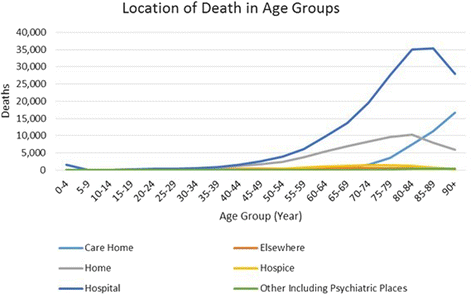Impact of place of residence on place of death in Wales: an observational study
- PMID: 29233123
- PMCID: PMC5727930
- DOI: 10.1186/s12904-017-0261-5
Impact of place of residence on place of death in Wales: an observational study
Abstract
Background: Previous research in England showed that deprivation level of a person's place of residence affects the place of death and quality of care received at the end of life. People dying in their preferred place of death has also been shown to act as an indication for high quality of end of life care services and social equality. This study expands on current research to explore the effects of deprivation and place of residence on health related choices and place of death in Wales.
Methods: We used ten years combined mortality statistics from 2005 to 2014 and Welsh Index of Multiple Deprivation rankings for each lower super output area. After accounting for the population's age, the number of deaths in Hospital, Hospice, Home, Care Home, Psychiatric Units, and Elsewhere were compared across deprivation quintiles.
Results: Distribution of place of death was found to be concentrated in three places - hospital (60%), home (21%) and care home (13%). Results from this study shows a high number of hospital deaths, especially for more deprived areas, despite being the least preferred place of death.
Conclusion: This is the first Welsh study investigating place of death in relation to deprivation, which could be of major importance to academics, end of life care providers and policy makers interested in to reduce health care inequality in Wales.
Keywords: Death place; Deprivation; Residence; Socioeconomic; Wales.
Conflict of interest statement
Ethics approval and consent to participate
This study was approved by the Bangor University Healthcare Sciences (Post-reg) Ethics and Research Committee (research proposal number 2016–15741). Secondary analysis of mortality data was approved by the Public Health Wales Observatory.
Consent for publication
Not applicable.
Competing interests
The authors declare that they have no competing interests.
Publisher’s Note
Springer Nature remains neutral with regard to jurisdictional claims in published maps and institutional affiliations.
Figures
References
Publication types
MeSH terms
LinkOut - more resources
Full Text Sources
Other Literature Sources
Medical



